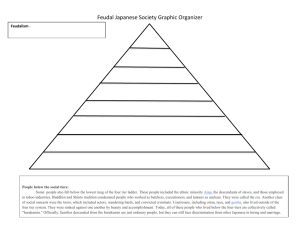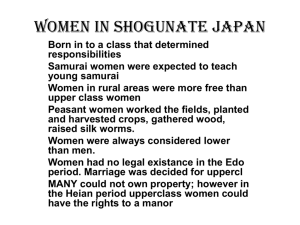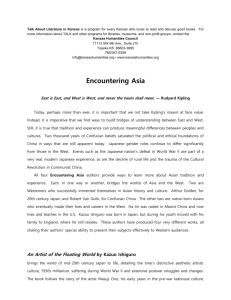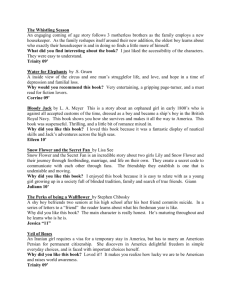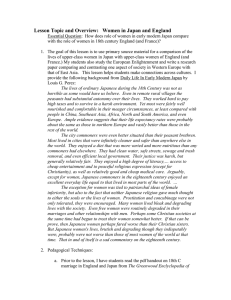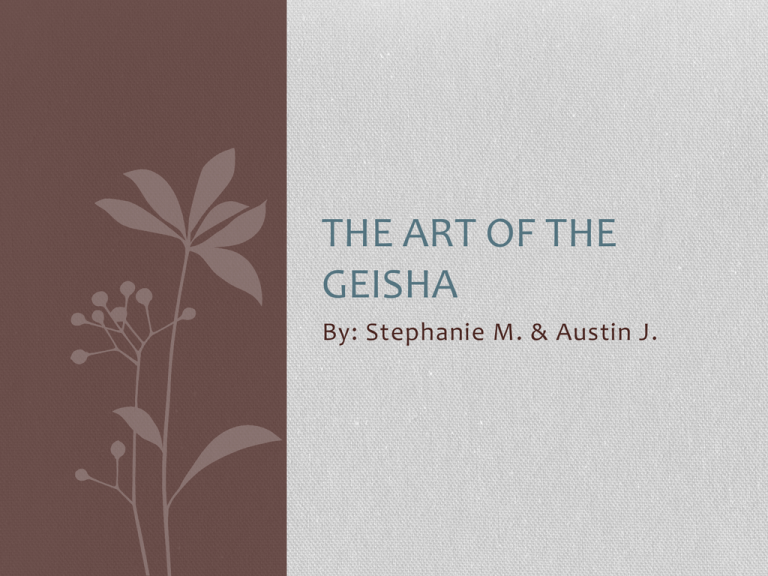
THE ART OF THE
GEISHA
By: Stephanie M. & Austin J.
THE VERY BEGINNING..
• As the 17th century wore on odoriko – trained teenage dancers – were growing in
popularity. By the late 18th century numerous performers within the pleasure
quarters had become famous artisans – elevation themselves above the
prostitution associated with the Tayu. Geisha could offer artistic entertainments music, singing, dancing, as well as social entertainments like story telling, lively
conversation, food and drink. All these could be offered at a reasonable price and
required only evening wear and perhaps portable items like fans or shamisens.
More importantly any teahouse or restaurant could serve as a venue for these
entertainers, no expensive brothel licenses or real estate in Yoshiwara.
REPRESENTED & NOT REPRESENTED
• The first geisha-like performers in recorded Japanese history are the saburuko,
"those who serve," who waited tables, made conversation, and sometimes sold
sexual favors.
• With a higher class of customers, a higher style of female entertainer also
developed in the pleasure quarters of Kyoto and other cities. Highly skilled in
dancing, singing and playing musical instruments such as the flute and shamisen,
the geisha did not rely on selling sexual favors for their income. All were trained in
the art of conversation and flirting. Among the most prized were geisha with a
talent for calligraphy, or those who could improvise beautiful poetry with hidden
layers of meaning on the spot.
• Samurai were not permitted to partake of kabuki theater performances or the
services of yujo by law; it was a violation of the class structure for members of the
highest class (warriors) to mix with social outcasts such as actors and prostitutes.
THE MESSAGE AND MEANING
• They dress and look the way they do to grab customer’s attention and to express
sensuality in a more cultural way.
• They are the means of entertainment. They are known the distraction form
everyday life.
FORM AND FUNCTION
• Means of entertainment for the people of the country or Western guests.
• They acted as hostess and some skills incudes performing various Japanese arts
such as classical music ,dance, games and conversation mainly to male customers.
• There were many different classifications and ranks of geisha. Some women
would have sex with their male customers, whereas others would entertain
strictly with their art forms. Prostitution was legal up until the 1900’s, so it was
practiced in many quarters throughout Japan.
http://www.youtube.com/watch?v=CUIHCPuXlgk
CONNECTED TO…
• A Geisha can be connected to another element such as Kabuki
• At the top of the Yujo hierarchy stood the Oiran, who were early kabuki theater
actresses as well as sex-trade workers.
• Yamato Japanese culture flourished during the Heian period, which witnessed the
establishment of a particular standard of beauty, as well as the origins of the
samurai warrior class. Shirabyoshi dancers and other talented female artists were
in high demand throughout the Heian era, which lasted until 1185.
TRANSITION THROUGH TIME
• Before the Geisha women, they resorted to prostitution and then
later on developed a name for themselves that took years of
training due to the means of entertaining by classical music, singing,
dancing, conversation and games.
NORMS, VALUES & PHILOSPHY
• Traditional Japanese norms and values embraced sexual delights and men were
not constrained to be faithful to their wives.
• The ideal wife was a modest mother and manager of the home, by Confucian
custom love was secondary importance. For sexual enjoyment and romantic
attachment, men did not go to their wives but to courtesans (geisha)
**Young girls were sold into the geisha life by their families until the mid 20th
century and were often subject to the ritual of “mizu-age” whereby their virginity
was sold to the highest bidder.**
INFLUENCE ON SOCIETY
• While geisha themselves are not prostitutes, their roots can be
found in Saburuko, late seventh century Japanese women who
were forced by eroding economic conditions and social
displacement to exchange sexual favours in order to survive.
• A Geisha is now considered a position that young girls strive to be in
society by training as early as 6 years of age.
CITATION
• http://www.youtube.com/watch?v=CUIHCPuXlgk
• http://geishaofjapan.com/
• http://asianhistory.about.com/od/japan/a/History-of-the-Geisha.htm
• http://www.newworldencyclopedia.org/entry/Geisha#History

